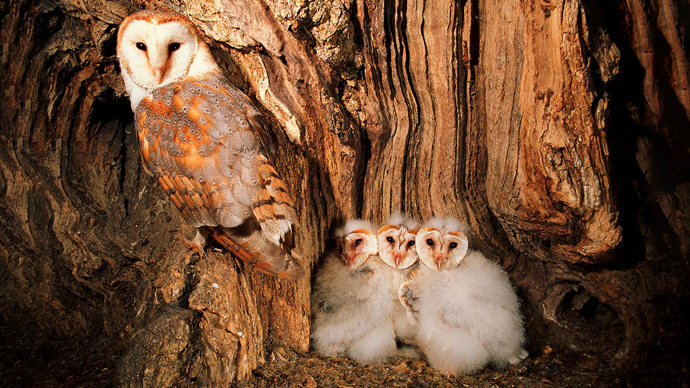Common names: barn owl
Scientific name: Tyto alba
Family: Tytonidae
Habitat: open countryside, roadside verges, farmland
Diet: small mammals including mice, shrews, rats and voles
Predators: buzzards, goshawks, occasionally foxes
Origin: native
With bright white feathers and a distinctive heart-shaped face, there’s no mistaking the barn owl. Catching sight of one on the wing is always a delight.
Common names: barn owl
Scientific name: Tyto alba
Family: Tytonidae
Habitat: open countryside, roadside verges, farmland
Diet: small mammals including mice, shrews, rats and voles
Predators: buzzards, goshawks, occasionally foxes
Origin: native
Barn owls are unmistakable; with their signature heart-shaped faces, bright white underparts and mottled golden-buff upperparts, these birds are a striking sight.
Like most owls and birds of prey, female barn owls are larger than males.
Not to be confused with: the short-eared owl, when in flight. Short-eared owls have bold yellow eyes and are more heavily patterned than barn owls.
Barn owls are avid hunters, scouring open grassland for small mammals such as voles, mice, shrews and rats. They catch prey with ease thanks to their incredible long-distance vision, sensitive hearing and silent flight.

Credit: Mike Read / naturepl.com
While there is no set breeding season for barn owls (when they breed largely depends on food supply), it usually falls between March and August. As their name suggests, barn owls nest in the cavities of old barns and buildings, as well as the hollows of trees. Their nests are built on top of the previous year’s debris.
Around 4-6 eggs are laid, hatching just over a month later. Chicks are ready to fledge at around two months old.
Barn owls are distributed across Great Britain and Ireland. They live in open countryside and farmland, and can often be seen on roadside verges.
In some areas barn owls were known as ‘demon owls’, due to the harrowing shrieks they make.
Despite their famously silent flight, it’s still possible to hear barn owls; their high-pitched screech is unmistakable.
Winter is probably the best time to see them on the wing as this is when they spend most of their time hunting in order to survive cold weather. Dusk is the best time to look out for them; however these owls do hunt during the day too.
These birds are fairly common – populations declined previously but are now recovering, although numbers are still in decline in Northern Ireland. It is believed changing agricultural practices and the development of barns and old buildings could be the cause of their decline, while the introduction of owl nesting boxes is helping the species.
Keep exploring